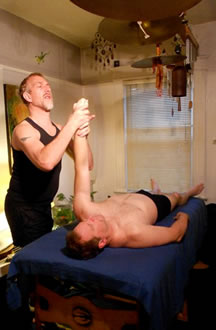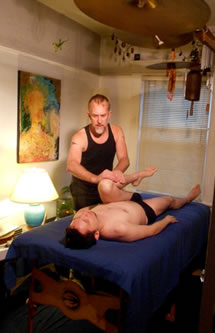Positioning-based Bodywork

Many kinds of bodywork might address, for example, tension in your neck and “bunched up” shoulders, with techniques that rub, knead, or press into the sore muscles. However, the gentle and powerful approach I take follows your shoulders’ upward movement at that moment and supports it briefly, until it releases internally. Related to acupressure and acupuncture in its understanding of the body. By definition, this work is about feeling good!
 Done in loose clothing on either my extra-wide massage table or a floor mattress, this work is effective at relaxing and energizing you or addressing a specific injury or condition: We can work toward relieving physical discomfort, resolution of a specific trauma, postural re-education, releasing tissue-held emotional patterns, etc. This work is about “listening to” and supporting your body’s natural self-healing movements.
Done in loose clothing on either my extra-wide massage table or a floor mattress, this work is effective at relaxing and energizing you or addressing a specific injury or condition: We can work toward relieving physical discomfort, resolution of a specific trauma, postural re-education, releasing tissue-held emotional patterns, etc. This work is about “listening to” and supporting your body’s natural self-healing movements.
I draw on over 200 hours of workshop training in OrthoBionomy ™ as well as training in massage and breathwork, and hundreds of hours of experience in session since 1993.
$90 / 90-minute session |
| To contact Heron about this work… | To go to the top of this page… |
| To read stories about this work… | To read client testimonials about this work… |
+++ TIP +++ Positioning
If some part of your physical body is feeling tired or stiff, gently stretch it keeping within, and just inside, the range of comfort. That is to say, don’t stretch PAST the point of comfort. You can help a body part relax by finding pairs of movements and going ever so slightly into the direction of comfort. So for example if your neck is tired, you can take one of three pairs of movements — right/left ear to shoulder, turning right/left, and chin up/chin down — and for each pair, move in each direction just to the edge of comfort, seeing which direction of the pair your body likes better. In other words, which one feels more comfortable and relaxing for your neck? …Always staying within the zone of your comfort, it doesn’t heal you to push you beyond that!! After determining which is more comfortable in that moment, go back into that direction of preference, staying just inside the edge of comfort, and breathe while you just stay there for a little bit — usually not more than 30 seconds. And come back to center. This practice increases blood flow and oxygenation to your tired body part and reminds your body how to be comfortable and at ease and strong.
I wish you strength and ease and health!
